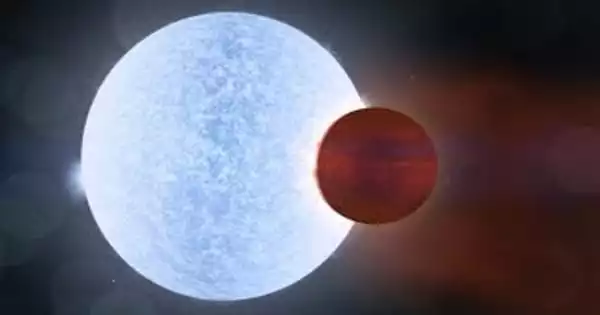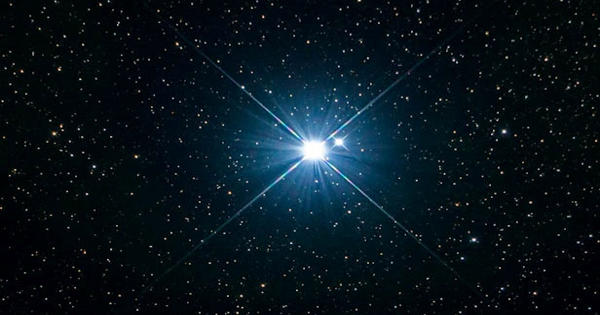KELT-9b is an exoplanet—specifically, an ultra-hot Jupiter—that orbits the late B-type/early A-type star KELT-9, which is around 670 light-years away from Earth. It is a gas giant that has 2.8 times the mass of Jupiter but barely half the density. Scientists expected the planet to have a smaller radius, but the strong radiation from its host star caused its atmosphere to expand up like a balloon. The discovery of KELT-9b, made with the Kilodegree Extremely Little Telescope, was announced in 2016.
The KELT-9 star is only 300 million years old, which is young in star time. It is more than twice as large, and nearly twice as hot, as our sun. Given that the planet’s atmosphere is constantly blasted with high levels of ultraviolet radiation, the planet may even be shedding a tail of evaporated planetary material like a comet.
Host star
The heat produced by KELT-9b is too intense for molecules to remain intact. Hydrogen gas molecules are most likely blasted apart on the dayside of tidally-locked KELT-9b, unable to recombine until their disjointed atoms migrate around to the planet’s nightside.
KELT-9b is a hotter planet than most stars, with a dayside temperature of more than 7,800 degrees Fahrenheit (4,600 Kelvin). However, its star, KELT-9, is significantly hotter – a blue A-type star that is most likely unraveling the planet by evaporation.

The star is 2-3 times the size and 2-6 times the mass of the sun. The host star, KELT-9, has a surface temperature of 10,170 K, which is exceptionally high for a system hosting a transiting planet. Prior to the discovery of KELT-9b, only six A-type stars were known to host planets, with WASP-33 being the warmest at 7,430 K; no B-type stars were previously known to host planets. KELT-9, also known as B9.5-A0, could be the first B-type star to be discovered with a planet. KELT-9b occupies a circular but strongly inclined orbit a mere 0.03462 AU from KELT-9 with an orbital period of less than 1.5 days.
Physical properties
KELT-9b is a relatively big giant planet with a mass roughly 2.8 times that of Jupiter; however, because its radius is nearly twice as large as Jupiter’s, its density is less than half that of Jupiter. KELT-9b, like many hot Jupiters, is tidally locked to its host star. The planet’s outer atmosphere nearly reaches its Roche lobe, signaling that the planet is undergoing rapid atmospheric escape due to the tremendous quantity of radiation it gets from its host star. In 2020, the rate of atmospheric loss was estimated to be 18 – 68 Earth masses per billion years.
KELT-9b is one of the hottest known exoplanets, with dayside temperatures surpassing 4,600 K — warmer than several low-mass stars as of January 2020. Molecules on the day side are broken down into their component atoms, allowing normally sequestered refractory elements, such as neutral oxygen, neutral and singly ionized atomic iron (Fe and Fe+), and singly ionized titanium (Ti+), to exist as atomic species, only to temporarily reform once they reach the cooler night side. Surprisingly, spectra taken in 2021 unequivocally confirmed the presence of metal oxides and hydrides in the planetary atmosphere, despite the absence of molecular emissions from the planetary dayside in better resolution spectra taken in 2021.
The thermosphere layer of KELT-9b is expected to heat up to 10000-11000 K, driven by ionization of heavy metals atoms like iron.
















